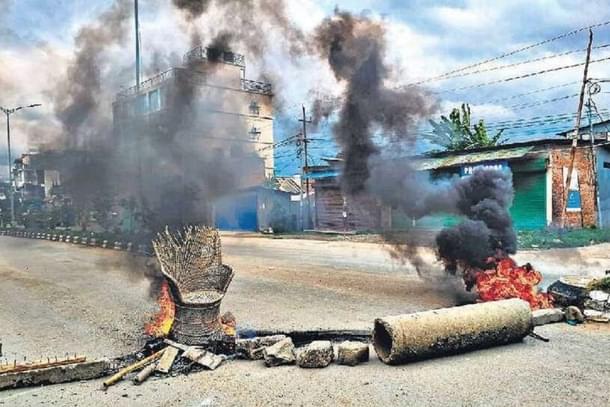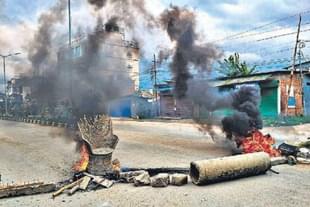North East
Cycle Of Killings And Counter-Killings Resumes In Manipur, Darker Days Ahead For State
Jaideep Mazumdar
Aug 06, 2023, 10:42 AM | Updated 05:08 PM IST
Save & read from anywhere!
Bookmark stories for easy access on any device or the Swarajya app.


The sickening cycle of killings and counter-killings resumed in Manipur Saturday (5 August) with Kuki militants brutally murdering three Meiteis at Kwakta Lamkai area of Bishnupur district early that morning.
A few hours later, in what appeared to be retaliatory action, two Kukis were shot dead in Churachandpur district.
Kwakta Lamkai falls in a ‘buffer zone’ created by security forces between the Kuki-dominated hills and Meitei-dominated Imphal Valley.
Such buffer zones have been created to keep the two warring sides (Meiteis and Kukis) apart. Central forces, primarily the Assam Rifles, are responsible for guarding the buffer zones and ensuring security to residents of such zones.
Kwakta Lamkai has a heavy presence of Assam Rifles troops. But that did not stop Kuki militants from sneaking into the area from the nearby hills of Churachandpur district, entering the houses of the victims and shooting them to death.
The bodies of the three Meitei men, a father-son duo among them, were badly mutilated by the killers. Such mutilation of victims’ bodies are the hallmark of Kuki militants who have always disfigured the bodies of people they kill to send a gruesome message to their adversaries.
The horrific killings led to widespread outrage in the entire Imphal Valley with protests and demonstrations, and open calls to arms to avenge the deaths of Meiteis, heightening ethnic tensions once again in the state.
Later on in the day (Saturday), two Kuki men were shot dead in an area on the fringes of the Kuki-dominated Churachandpur district.
That, again, triggered loud protests by Kuki groups who have not only vowed revenge, but also resolved to intensify their demands for a separate state for Kukis carved out of Manipur.
Saturday (5 August)’s killings and counter-killings come in the aftermath of the postponement of a mass burial of bodies of Kukis killed in the ethnic violence at a site the Meiteis claim as their own.
The mass burial, scheduled for Friday (4 August) forenoon, was postponed by the organisers — the Indigenous Tribal Leaders’ Forum (ITLF), an apex body of Kuki groups — at the last moment after appeals from the Union Home Minister and Mizoram Chief Minister, and an early morning injunction by the Manipur High Court (read this).
But the ITLF’s announcement of the mass burial had already inflamed passions with the Meiteis opposing it vehemently.
The Meiteis said that the proposed site of the burial — Torbung Bangla on the edge of Bishnupur district bordering Churachandpur — belongs to Meiteis who were driven out of the area by Kuki militants in early May.
Meitei organisations who have come together under the Coordinating Committee On Manipur’s Integrity (COCOMI) had said they will thwart the mass burial by force if necessary.
The COCOMI had mobilised thousands of men and women to go to Torbung Bangla to prevent the mass burial. Meitei mobs clashed with security forces who stopped them from travelling to Torbung Bangla Friday (4 August).
But the deferment of the mass burial, even if for a week, did not douse inflamed passions because the ITLF laid down conditions — three of them impossible to meet (read this).
One of the demands — fast-tracking talks between the Union Government and Kukis for creating a separate state for Kukis — took matters to the edge with Meiteis vowing to shed blood to protect Manipur’s territorial integrity.
The CONCOMI has planned a series of protests in the Imphal Valley from Sunday (6 August) to record the Meiteis’ opposition to any proposal to divide their state.
The CONCOMI has warned that the situation will turn far worse (than what it is now) if any attempts are made to thwart the protests and if the union government takes a single step towards even considering the Kukis’ demand for a separate state.
Nightmare For Security Forces:
The proliferation of firearms in the state, and the resurgence of both Meitei and Kuki insurgent outfits, has come as a nightmare for security forces.
Apart from the 4,000-odd automatic rifles, light machine guns, mortars and small arms looted from police armouries in the state in May-June by Meitei mobs, armed Meitei men and women looted 295 sophisticated and automatic rifles and 16,000 rounds of assorted ammunition from another Manipur Police armoury Friday (4 August).
“Firearms have proliferated and even common citizens, both Meiteis and Kukis, either possess or have easy access to sophisticated arms and even sniper rifles. While the Meteis have the arms looted from police armouries, the Kukis possess sophisticated weapons that have been smuggled in from Myanmar in the recent past in large quantities,” a senior officer posted at the headquarters of the Army’s 3 Corps (also known as the ‘Spear Corps’) at Dimapur in Nagaland told Swarajya.
Though the Army and Assam Rifles have launched operations to recover stolen and smuggled arms, they have met with little success due to the non-cooperation and open hostility of local communities.
Distrust Of, And Between, Men In Uniform:
What has added to the highly volatile mix in Manipur is the deep distrust of security forces by both the communities, and between the Manipur Police and Assam Rifles.
The Kukis have no faith in the Manipur Police, a Meitei-dominated force that they accuse of deep bias. Kukis allege that Manipur Police have looked the other way or even participated in attacks on Kukis.
Kukis have been demanding the withdrawal of Manipur Police from the hill districts and their replacement by Army and Assam Rifles.
The Meiteis, on the other hand, allege that the Assam Rifles is protecting the Kukis. Meitei community leaders say that Assam Rifles units that are stationed permanently in the hills have developed deep affinities with local Kukis and are shielding Kuki militants.
Meiteis also allege that the Assam Rifles has allowed Kuki militants to retain their arms in violation of the tripartite 'Suspension Of Operations' agreement (between the state and union governments and the Kuki militants) that the Manipur government unilaterally revoked in March this year.
The Assam Rifles is also accused of being soft on Kukis and very harsh on Meiteis. This widespread feeling of distrust has made the task of not only the Assam Rifles, but also of the Army, very difficult.
The Manipur Police allege that Assam Rifles units stop them from carrying out operations against Kuki militants who attack Meiteis. The police also allege that the Assam Rifles also fails in its duty to protect Meiteis from attacks by Kukis.
After Saturday (5 August) morning’s killings of three Meiteis at Kwakta Lamkai, the Manipur Police got into a heated altercation with Assam Rifles over the latter stopping the police from reaching the site of the killings and launching combing operations against the Kuki militants.
Manipur Police have often complained of Assam Rifles soldiers preventing them from responding to SOS calls from Meiteis under attack from Kuki militants.
A senior Assam Rifles officer at the headquarters of the force’s divisional headquarters (called the Inspectorate General Assam Rifles-South, or IGAR-S) at Mantripukhri in Imphal told Swarajya that the responsibility of maintaining security and carrying out operations in the ‘buffer zones’ has been given to the Army and Assam Rifles.
“Our responsibilities are clearly laid out in the new protocol designed by the Unified Command (of all security forces and the police) and we are scrupulously sticking to it. We will not allow its violation,” the officer, who did not want to be named, told Swarajya.
But the police have their own version.
“The Assam Rifles does not take its task of protecting Meitei inhabitants in buffer zones seriously and is soft on Kuki militants. The killings at Kwakta Lamkai early Saturday morning are an example of Assam Rifles’ failure. They will not do their job, and will prevent us from protecting innocent civilians. That is unacceptable,” said an additional SP of a district in Imphal Valley.
But this deep distrust, and open hostility, between the two forces can spiral out of control and result in a tragedy anytime, say Army officers.
“Saturday’s incident was captured on video and showed policemen aggressively confronting Assam Rifles soldiers. Some policemen can be seen cocking their rifles and pointing them menacingly towards the Assam Rifles menacingly while ordering them to leave the place,” said a Colonel-ranked officer posted at the Army’s 57 Mountain Division headquarters at Leimakhong in the outskirts of Imphal city told Swarajya.
"Tempers can flare up and things can go out of control any time if the policemen are not reined in by their superiors," he added. This officer saw the video.
A similar video of a confrontation (watch this video) between Assam Rifles and policemen has gone viral and shows the extent of open hostility between the two forces.
The Army fears that if a single bullet is fired by the police in a fit of rage and results in a mishap, there will be no stopping a bloodbath.
“The Assam Rifles is a well-trained force and is very disciplined. The men have shown tremendous restraint even under extreme pressure and provocation by the police, as was seen in Saturday’s video. But if any (Assam Rifles) soldier comes to bodily harm by a policeman, there is no saying what can happen after that,” the army officer said.
This element has exacerbated the situation in Manipur. Matters can only be allowed to drift at the peril of the state, and the entire Northeast.
Also read:





